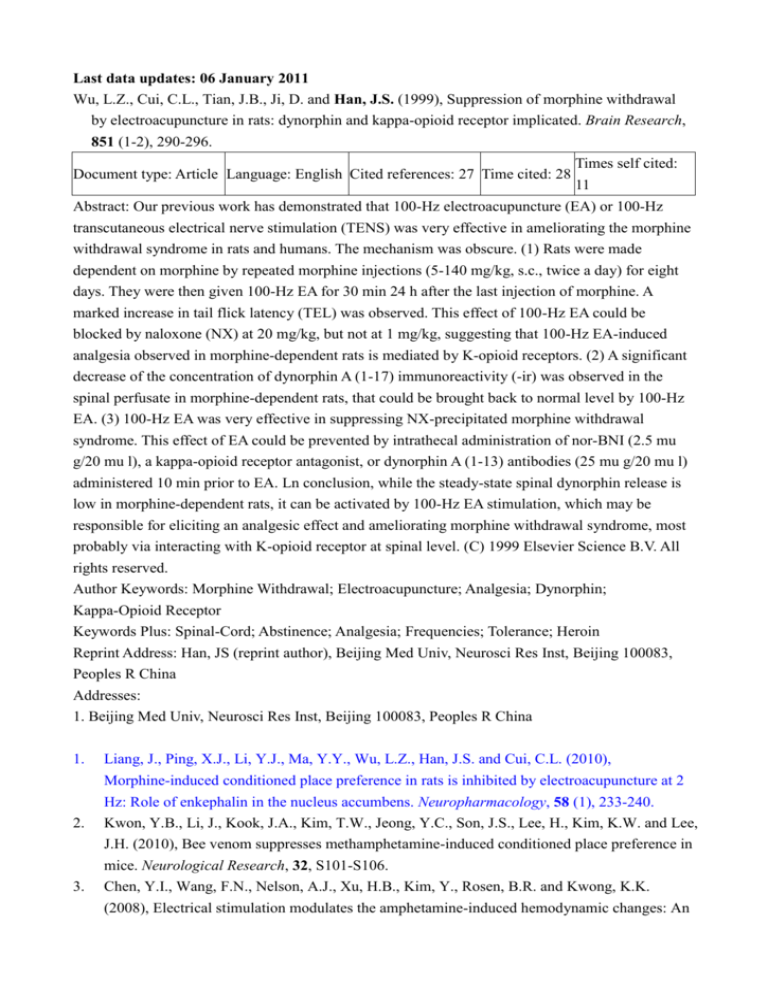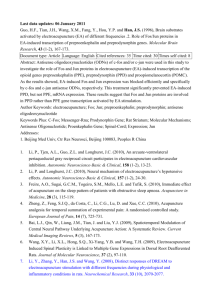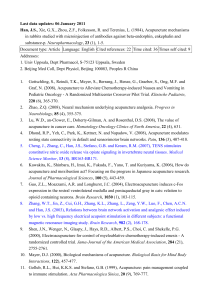
Last data updates: 06 January 2011
Wu, L.Z., Cui, C.L., Tian, J.B., Ji, D. and Han, J.S. (1999), Suppression of morphine withdrawal
by electroacupuncture in rats: dynorphin and kappa-opioid receptor implicated. Brain Research,
851 (1-2), 290-296.
Document type: Article Language: English Cited references: 27 Time cited: 28
Times self cited:
11
Abstract: Our previous work has demonstrated that 100-Hz electroacupuncture (EA) or 100-Hz
transcutaneous electrical nerve stimulation (TENS) was very effective in ameliorating the morphine
withdrawal syndrome in rats and humans. The mechanism was obscure. (1) Rats were made
dependent on morphine by repeated morphine injections (5-140 mg/kg, s.c., twice a day) for eight
days. They were then given 100-Hz EA for 30 min 24 h after the last injection of morphine. A
marked increase in tail flick latency (TEL) was observed. This effect of 100-Hz EA could be
blocked by naloxone (NX) at 20 mg/kg, but not at 1 mg/kg, suggesting that 100-Hz EA-induced
analgesia observed in morphine-dependent rats is mediated by K-opioid receptors. (2) A significant
decrease of the concentration of dynorphin A (1-17) immunoreactivity (-ir) was observed in the
spinal perfusate in morphine-dependent rats, that could be brought back to normal level by 100-Hz
EA. (3) 100-Hz EA was very effective in suppressing NX-precipitated morphine withdrawal
syndrome. This effect of EA could be prevented by intrathecal administration of nor-BNI (2.5 mu
g/20 mu l), a kappa-opioid receptor antagonist, or dynorphin A (1-13) antibodies (25 mu g/20 mu l)
administered 10 min prior to EA. Ln conclusion, while the steady-state spinal dynorphin release is
low in morphine-dependent rats, it can be activated by 100-Hz EA stimulation, which may be
responsible for eliciting an analgesic effect and ameliorating morphine withdrawal syndrome, most
probably via interacting with K-opioid receptor at spinal level. (C) 1999 Elsevier Science B.V. All
rights reserved.
Author Keywords: Morphine Withdrawal; Electroacupuncture; Analgesia; Dynorphin;
Kappa-Opioid Receptor
Keywords Plus: Spinal-Cord; Abstinence; Analgesia; Frequencies; Tolerance; Heroin
Reprint Address: Han, JS (reprint author), Beijing Med Univ, Neurosci Res Inst, Beijing 100083,
Peoples R China
Addresses:
1. Beijing Med Univ, Neurosci Res Inst, Beijing 100083, Peoples R China
1.
Liang, J., Ping, X.J., Li, Y.J., Ma, Y.Y., Wu, L.Z., Han, J.S. and Cui, C.L. (2010),
Morphine-induced conditioned place preference in rats is inhibited by electroacupuncture at 2
2.
Hz: Role of enkephalin in the nucleus accumbens. Neuropharmacology, 58 (1), 233-240.
Kwon, Y.B., Li, J., Kook, J.A., Kim, T.W., Jeong, Y.C., Son, J.S., Lee, H., Kim, K.W. and Lee,
J.H. (2010), Bee venom suppresses methamphetamine-induced conditioned place preference in
3.
mice. Neurological Research, 32, S101-S106.
Chen, Y.I., Wang, F.N., Nelson, A.J., Xu, H.B., Kim, Y., Rosen, B.R. and Kwong, K.K.
(2008), Electrical stimulation modulates the amphetamine-induced hemodynamic changes: An
fMRI study to compare the effect of stimulating locations and frequencies on rats.
4.
Neuroscience Letters, 444 (2), 117-121.
Cui, C.L., Wu, L.Z. and Luo, F. (2008), Acupuncture for the treatment of drug addiction.
5.
Neurochemical Research, 33 (10), 2013-2022.
Yang, C.H., Lee, B.H. and Sohn, S.H. (2008), A possible mechanism underlying the
effectiveness of acupuncture in the treatment of drug addiction. Evidence-Based
6.
Complementary and Alternative Medicine, 5 (3), 257-266.
Ma, Y.Y., Shi, X.D., Han, J.S. and Cui, C.L. (2008), Peripheral electrical stimulation-induced
suppression of morphine-induced CCP in rats: A role for dopamine in the nucleus accumbens.
7.
Brain Research, 1212, 63-70.
Chae, Y., Yeom, M., Han, J.H., Park, H.J., Hahm, D.H., Ac, I.S., Lee, H.S. and Lee, H. (2008),
Effect of acupuncture on anxiety-like behavior during nicotine withdrawal and relevant
8.
mechanisms. Neuroscience Letters, 430 (2), 98-102.
Chu, N.N., Xia, W., Yu, P., Hu, L., Zhang, R. and Cui, C.L. (2008), Chronic
morphine-induced neuronal morphological changes in the ventral tegmental area in rats are
9.
reversed by electroacupuncture treatment. Addiction Biology, 13 (1), 47-51.
Chu, N.N., Zuo, Y.F., Meng, L., Lee, D.Y.W., Han, J.S. and Cui, C.L. (2007), Peripheral
electrical stimulation reversed the cell size reduction and increased BDNF level in the ventral
tegmental area in chronic morphine-treated rats. Brain Research, 1182, 90-98.
10. Liu, S., Zhou, W.H., Ruan, X.Z., Li, R.H., Lee, T.T., Weng, X.C., Hu, J. and Yang, G.D.
(2007), Activation of the hypothalamus characterizes the response to acupuncture stimulation
in heroin addicts. Neuroscience Letters, 421 (3), 203-208.
11. Chien, C.H., Tsai, Y.C., Tseng, C.Y., Huang, B.M. and Chang, Y.H. (2007), The spatial and
segmental innervation of somatic acupoint - A study of canine Shen-Shu point (BL-23).
American Journal of Chinese Medicine, 35 (3), 437-446.
12. Johnston, M.F., Yang, C.Q., Hui, K.K., Xiao, B., Li, X.X. and Rusiewicz, A. (2007),
Acupuncture for chemotherapy-associated cognitive dysfunction: A hypothesis-generating
literature review to inform clinical advice. Integrative Cancer Therapies, 6 (1), 36-41.
13. Zhao, R.J., Yoon, S.S., Lee, B.H., Kwon, Y.K., Kim, K.J., Shim, I., Choi, K.H., Kim, M.R.,
Golden, G.T. and Yang, C.H. (2006), Acupuncture normalizes the release of accumbal
dopamine during the withdrawal period and after the ethanol challenge in chronic
ethanol-treated rats. Neuroscience Letters, 395 (1), 28-32.
14. Kim, J.H., Chung, J.Y., Kwon, Y.K., Kim, K.J., Yang, C.H., Hahm, D.H., Lee, H.J., Pyun,
K.H. and Shim, I. (2005), Acupuncture reduces alcohol withdrawal syndrome and c-Fos
expression in rat brain. American Journal of Chinese Medicine, 33 (6), 887-896.
15. Dong, H.W., Wang, L.H., Zhang, M. and Han, J.S. (2005), Decreased dynorphin A(1-17) in
the spinal cord of spastic rats after the compressive injury. Brain Research Bulletin, 67 (3),
189-195.
16. Kim, M.R., Kim, S.J., Lyu, Y.S., Kim, S.H., Lee, Y.K., Kim, T.H., Shim, I., Zhao, R.J.,
Golden, G.T. and Yang, C.H. (2005), Effect of acupuncture on behavioral hyperactivity and
dopamine release in the nucleus accumbens in rats sensitized to morphine. Neuroscience
Letters, 387 (1), 17-21.
17. Chen, J.H., Liang, J., Wang, G.B., Han, J.S. and Cui, C.L. (2005), Repeated 2 Hz peripheral
electrical stimulations suppress morphine-induced CPP and improve spatial memory ability in
rats. Experimental Neurology, 194 (2), 550-556.
18. Liu, S., Zhou, W.H., Liu, H.F., Yang, G.D. and Zhao, W.K. (2005), Electroacupuncture
attenuates morphine withdrawal signs and c-Fos expression in the central nucleus of the
amygdala in freely moving rats. Brain Research, 1044 (2), 155-163.
19. Shi, X.D., Wang, G.B., Ma, Y.Y., Ren, W., Luo, F., Cui, C.L. and Han, J.S. (2004), Repeated
peripheral electrical stimulations suppress both morphine-induced CPP and reinstatement of
extinguished CPP in rats: accelerated expression of PPE and PPD mRNA in NAc implicated.
Molecular Brain Research, 130 (1-2), 124-133.
20. Chae, Y.Y., Yang, C.H., Kwon, Y.K., Kim, M.R., Pyun, K.H., Hahm, D.H., Lee, H.J. and
Shim, I. (2004), Acupuncture attenuates repeated nicotine-induced behavioral sensitization and
c-Fos expression in the nucleus accumbens and striatum of the rat. Neuroscience Letters, 358
(2), 87-90.
21. Kim, J.H., Min, B.I., Na, H.S. and Park, D.S. (2004), Relieving effects of electroacupuncture
on mechanical allodynia in neuropathic pain model of inferior caudal trunk injury in rat:
mediation by spinal opioid receptors. Brain Research, 998 (2), 230-236.
22. Shi, X.D., Ren, W., Wang, G.B., Luo, F., Han, J.S. and Cui, C.L. (2003), Brain
opioid-receptors are involved in mediating peripheral electric stimulation-induced inhibition of
morphine conditioned place preference in rats. Brain Research, 981 (1-2), 23-29.
23. Wan, X.W., Huang, M., He, Y.Q., Li, W.H., You, Z.D. and Lu, C.L. (2003), Involvement of
dynorphin A in the inhibition of morphine physical dependence by N-nitro-L-arginine in rats.
Chinese Medical Journal, 116 (7), 1055-1058.
24. Rabinstein, A.A. and Shulman, L.M. (2003), Acupuncture in clinical neurology. Neurologist, 9
(3), 137-148.
25. Han, J.S. (2003), Acupuncture: neuropeptide release produced by electrical stimulation of
different frequencies. Trends in Neurosciences, 26 (1), 17-22.
26. Ren, Y.H., Wang, B., Luo, F., Cui, C.L., Zheng, J.W. and Han, J.S. (2002), Peripheral electric
stimulation attenuates the expression of cocaine-induced place preference in rats. Brain
Research, 957 (1), 129-135.
27. Bullock, M.L., Kiresuk, T.J., Sherman, R.E., Lenz, S.K., Culliton, P.D., Boucher, T.A. and
Nolan, C.J. (2002), A large randomized placebo controlled study of auricular acupuncture for
alcohol dependence. Journal of Substance Abuse Treatment, 22 (2), 71-77.
28. Vaccarino, A.L. and Kastin, A.J. (2000), Endogenous opiates: 1999. Peptides, 21 (12),
1975-2034.








